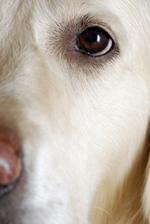
The eye is a sphere filled with fluids. Cells inside the eye produce aqueous humor, the clear fluid that gives the eye its shape and provides nourishment for tissues in the eye. The drainage angle is the area that allows aqueous humor to flow out into the bloodstream. Through these two processes, a balance is maintained that keeps the eye healthy.
Pressure can build up due to inadequate fluid drainage caused by inflammation, injury, tumors, or other malformations or diseases of the eye. When fluid pressure builds up too much, a condition called glaucoma occurs, which may damage the optic nerve. This optic nerve damage impairs vision, whether in pets or in people. Some breeds of dog, such as Cocker Spaniel and Siberian Husky, are more likely to be affected by glaucoma than other breeds. Primary glaucoma is rare in cats.
Symptoms and Types
PetMD describes glaucoma symptoms this way:
There are two main types of glaucoma: primary and secondary. Symptoms for sudden primary disease, due to the eye’s inability to drain through the filtration angles of the eye, are as follows:
- High pressure within the eye
- Blinking of the eye
- The eyeball may recede back into the head
- Redness of the blood vessels in the whites of eyes
- Cloudy appearance at front of the eye
- Dilated pupil – or pupil does not respond to light
- Vision loss
Long-term, advanced disease:
- Enlargement of the eyeball (buphthalmos)
- Obvious loss of vision
- Advanced degeneration within the eye
Symptoms for secondary glaucoma, or glaucoma due to secondary eye infection(s), include:
- High pressure within the eye
- Redness of the blood vessels in the whites of eyes
- Cloudy appearance at front of the eye
- Inflammatory debris visible in the front of the eye
- Possible constriction of the pupil
- Possible sticking of the iris to either the cornea or the lens
- Possible that the edge of the iris circularly sticks to the lens
In addition, there may be:
- Headaches, with head pressing to relieve feelings of pressure in head
- Loss of appetite
- Change in attitude, less desire to play or interact
Measuring Pressure Inside the Eye
Does your pet have high pressure inside their eye? The only way to know for sure is to have a veterinarian test the intraocular pressure (IOP) with a process called tonometry. Some signs of high pressure may include bloodshot eyes or a cloudy cornea, but often any changes to the eye are not noticeable to a pet owner. The eye may eventually become noticeably enlarged from the pressure. By this time, irreversible vision loss has probably taken place. Even if vision loss begins, it may not be noticeable because the pet may be able to navigate by compensating very effectively with the other eye. This is one of the reasons it is so important to have a yearly wellness exam with your veterinarian or possibly even more frequently if your pet is over 7 years of age.


